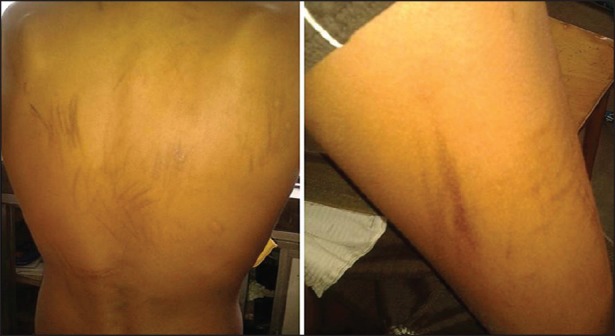Flagellate erythema induced by bleomycin toxicity
CC BY-NC-ND 4.0 · Indian J Med Paediatr Oncol 2013; 34(04): 334
DOI: DOI: 10.4103/0971-5851.125265
Abstract
Bleomycin is a chemotherapeutic antibiotic used in various malignancies. Its toxicity is mainly lung and skin with marrow sparing effect. Here we would like to describe a characteristic skin reaction developed because of bleomycin in a case of intracranial germ cell tumor. Flagellate erythema which is a self-limiting toxic reaction can cause residual hyperpigmentation.
Publication History
Article published online:
19 July 2021
© 2013. Indian Society of Medical and Paediatric Oncology. This is an open access article published by Thieme under the terms of the Creative Commons Attribution-NonDerivative-NonCommercial-License, permitting copying and reproduction so long as the original work is given appropriate credit. Contents may not be used for commercial purposes, or adapted, remixed, transformed or built upon. (https://creativecommons.org/licenses/by-nc-nd/4.0/.)
Thieme Medical and Scientific Publishers Pvt. Ltd.
A-12, 2nd Floor, Sector 2, Noida-201301 UP, India
Abstract
Bleomycin is a chemotherapeutic antibiotic used in various malignancies. Its toxicity is mainly lung and skin with marrow sparing effect. Here we would like to describe a characteristic skin reaction developed because of bleomycin in a case of intracranial germ cell tumor. Flagellate erythema which is a self-limiting toxic reaction can cause residual hyperpigmentation.
CASE
A 15-year-old boy diagnosed as intracranial germ cell tumor underwent surgery, followed by cranial radiotherapy (45 Gy) and later treated with Bleomycin, Etoposide and Cisplatin(BEP) regimen. After third cycle of chemotherapy, he developed asymptomatic erythematous rashes over the back, chest and thighs, which later subsided with persistence of hyperpigmentation [Figure 1].

| Fig. 1 Hyperpigmentation of flagellate erythematous rash over the back and thigh
Bleomycin is a chemotherapeutic antibiotic associated with various skin related toxicities such as Raynaud's phenomenon, flagellate erythema, and sclerodermoid reaction. In the acute stage they are erythematous rashes later may persist as hyperpigmentation marks.[1] Other conditions which may be associated with flagellate erythema are docetaxel, adult Still's disease, dermatomyositis and ingestion of shiitake mushrooms.[2] During the acute phase, topical with or without oral steroids may reduce symptoms.
Footnotes
Source of Support: Nil
Conflict of Interest: None declared.
REFERENCES

| Fig. 1 Hyperpigmentation of flagellate erythematous rash over the back and thigh


 PDF
PDF  Views
Views  Share
Share

